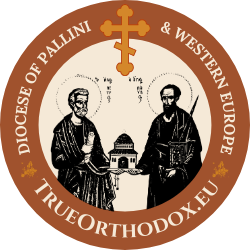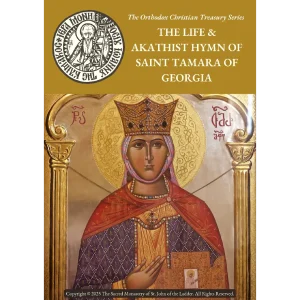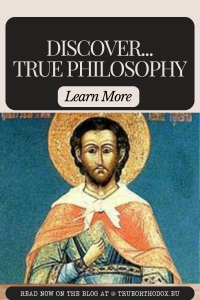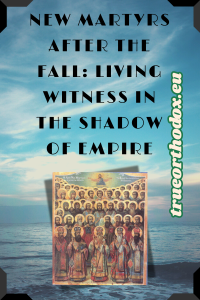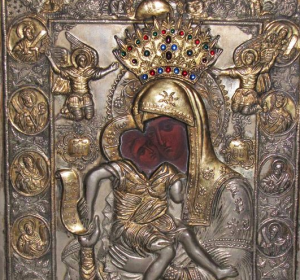How Abbess Sophia of Kiev Should Change Your View of the “Official Patriarchate” – Celebrated March 22
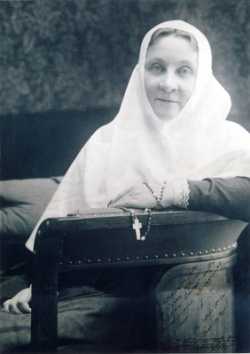
Abbess Sophia of Kiev
CATACOMB ABBESS OF THE PROTECTION CONVENT
Commemorated March 22 (†1941)
The righteous doth sing and rejoice
Prov. 29:6
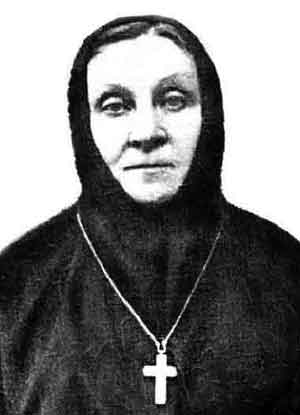
OF INESTIMABLE SPIRITUAL VALUE is the fearless stand for Christ’s Truth by the New Martyrs of Russia. Especially by their manful act of testifying where the Truth was to be found at a time when many did not see this — the Josephite confessors of 1927 and thereafter historically preserved the savor of Orthodoxy for generations to follow. Now that almost half a century has passed, history has shown that these “stubborn rebels,” the followers of Metropolitan Joseph of Petrograd, were absolutely correct, and their significance now shines forth as equal to that of the great Confessors of Orthodoxy in ancient times.
One of such Josephites was Abbess Sophia, whose boldness as a confessor was a direct result of her high spirituality and genuine Orthodox world-view. She reached spiritual maturity at the time of Russia’s pinnacle of holiness when the Russian land was preparing to offer itself as a pure and ripe sacrifice to God at the bloody hands of the God-hating Communists.
The future Abbess, Sophia Grineva, was born in 1873 in a wealthy landowner’s family. The Tula and Kaluga region, sanctified by Optina Monastery and its remarkable influence on all phases of religious life, was the countryside where the young Sophia received her upbringing and spiritual formation. When her father died, the children stayed for a while in the convent of her native town of Belev, which was under the direct spiritual direction of the Optina Elders, and whose abbess was their family’s former governess. They often visited Optina Monastery, where once Elder Anatole prophetically called the 12-year-old Sonia an “abbess.” But it was discovered that she had a very good voice, and so she was sent to the musical conservatory to study for a career in opera. This, however, did not satisfy the heart of God’s chosen one, which was striving for higher things, and her soul longed for monastic struggle.
Not far from the Grinev estate lived a wealthy landowner, Znamensky, whose daughter Anna, having just completed her higher education, abandoned all thought of an upper-class career and, out of religious zeal, preferred to become a village school teacher. Being aflame with monastic striving, she would give spiritual lectures with the singing of akathists, ending late at night. These were attended by more than 400 people. Anna and Sophia became close friends. Late one winter evening, going through the deserted woods to Anna’s lecture, Sophia encountered a wolf, and her death seemed certain, since these beasts, who plagued this territory, were not only cattle-killers but had recently even killed an armed officer. Here she made a vow to become a nun if she remained alive. She made the sign of the Cross over the wolf, and at once he ran away into the woods. Soon Sophia caught a severe cold and lost her voice, thus ending her worldly pursuits. By that time Anna had asked and received her share of land from her father’s inheritance, and together with ten other young women she settled in a remote and deserted wooded area and began to lead a severe monastic life, with the blessing of several holy men: St. John of Kronstadt, Elder Ambrose of Optina, Elder Barnabas of the Gethsemene Skete, and others. The girls built huts for their dwelling out of branches and boards, slept on the earthen floor with a rock for a pillow, ate dry bread, and only on feast days had some warm weak barley soup. Soon the news spread of this genuine skete-life, and Sophia joined Anna. Anna with her spiritual daughters felled trees, chopped firewood, dug a well and built a beautiful church, dedicated to the Holy Trinity, where they conducted the whole daily cycle of Divine services. Life was hard but very rewarding. The community flourished, with over 600 sisters, an orphanage, an old-age home, a large vegetable garden and orchard, a brick factory, and metochia in Moscow and Petersburg. But Anna, overwhelmed by her success, suffered a grave spiritual catastrophe: she was lured into spiritism and left the convent. Dissension struck the convent, and some sisters left. Sophia went to a holy Elder, Gerasimus of Kaluga, who had just opened the St. Nicholas Convent for his spiritual daughters.
Father Gerasimus, himself a spiritual son of Elder Ambrose of Optina, had a spiritual son, Misha, who later received the name of his Elder, Gerasimus. He later became as clairvoyant as his Elder and founded a St. Sergius Skete, where he gave spiritual healing to many suffering ones. Between him and Sophia there developed a spiritual friendship which lasted for life; later they would send spiritually crippled people to each other for healing. Following his example, Sophia left the convent with another sister and went to found an independent community. On the bank of the beautiful Oka River, there was an abandoned church of St. John the Almsgiver. There the young sisters settled in order to continue their “narrow path” of poverty, daily church services, and labor. Their life inspired followers, and a new community, dedicated to the Icon of the Most Holy Theotokos “Comfort and Consolation,” grew rapidly and soon became a spring of spiritual enlightenment also for the workers of a local factory, who were mostly ex-convicts.
When the church authorities noticed the gifts of Abbess Sophia, they made her head of one of the largest convents in Russia, that of the Protection of the Mother of God in Kiev, a post which she accepted in hope of being able to help financially her own convent, which was in need of funds. The city convent in Kiev was so large that it possessed a large city hospital, in addition to other charitable institutions. But Mother Sophia was as guileless and simple as before. This is where the Revolution found her.
Being a true offspring of the Optina Elders, with whom she was in constant contact, she soberly discerned the true nature of the Soviet Revolution and knew what to expect from it. Thus, when the assault of the “Living Church” struck, her convent was one of the first to give a blowback, although she herself had already been arrested. A new calendarist bishop was forced into the convent by GPU agents to serve Liturgy. When the women who attended it came up to kiss the Cross at the end, one after another they spit on the bishop’s hand that held the Cross, and thus an end was put to “renovation” in the Protection Convent, and the bishop learned his lesson and repented. Hearing about this, Bishop Damascene (see below) exclaimed with bitterness: “If it were not for women, who else would defend the Church? Let them at least defend it however they can!”
Abbess Sophia was arrested and released several times in the period before Metropolitan Sergius’ “Declaration” of betrayal to the Church in 1927. Mother Sophia and her clergy, led by the young Father Dimitry Ivanov, were the first ones in Kiev who openly rejected it. Unfortunately, they were supported by few of the other clergy, while most of the local bishops were silent, in effect accepting the “Declaration.” The Convent was confused and divided because of this, and Abbess Sophia thought it wiser to leave the Convent with Father Dimitry and twenty sisters of like mind. A wealthy lady, Mrs. Barbenko, offered her summer home in the Kiev suburb of Irpen as a refuge for the confessors; at this time a miraculous spring had been discovered nearby.
Living there, of course, was not easy since an intensified persecution was being directed against all Josephites. In the house where the nuns lived there was a hall adorned with paintings. At night they were taken down and replaced by icons, and all night long fervent prayer was offered in special vigils. In the morning the paintings were replaced, and no outsiders could know that this was a catacomb church, which served as a spiritual center for the true Orthodox Christians of the whole Kiev area.
There exists an anti-Sergianist document from this circle, a letter written from a person close to Abbess Sophia to a friend abroad in 1933. To get around the Soviet censor, the church situation is thinly disguised behind a discussion of “doctors.” The person who received it immediately understood, of course, that “Dr. Sergiev” is Metropolitan Sergius, the “old men Petrov and Kirillov” are the elder hierarchs, Metropolitans Peter and Cyril, who refused to accept the “Declaration”; the “clinics and drugstores” are churches; and “treatment” is Holy Communion and the other Holy Mysteries. Here is the document:
“None of our people have any contact with the doctors of Sergiev, and we do not go to his clinics for treatment. He has acted completely illegally, since the old man, Dr. Petrov, only assigned him as his replacement for current business when he had to go away, but Sergiev, without consultation of all the doctors, took over the administration, which he directs in all matters. The old men Petrov and Kirillov do not recognize this administration and both of them are in persecutions and sorrows. My husband was very upset with the activities of Dr. Sergiev because all the zealots of true homeopathy (Orthodoxy) are deprived of the possibility of treatment since all the drug stores are in the hands of those who have taken over everything. It is difficult to explain to you, but if you know everything, it is unacceptable. I will tell you one thing: I was in Chernigov the whole time without a doctor and traveled to Kiev [Mother Sophia) when it was necessary, that is, once or twice a year. Here also the children have not gone for treatment.”
The leading anti-Sergianist hierarch in the Kiev area was the bright figure of the Bishop-Confessor Damascene (Cedrick), who was spiritually very close to Abbess Sophia. He wrote flaming appeals showing the ruinousness of Metropolitan Sergius’ policy in every aspect. His stirring appeals were secretly copied and re-copied by Orthodox zealots, and some of them reached the free world, where they were distributed and recently printed by his secretary. His deep concern was for the future of true, unadulterated Orthodoxy in Russia, a concern shared by his friend, Metropolitan Cyril, and, of course, by Abbess Sophia. The only answer to the church situation, he thought, was to prepare for the end of the world and cease thinking about a church “organization.” He was often arrested, released for a short time, and then exiled again and again. On one such visit, when Mother Sophia was also free from prison for a time, he tonsured her in the Great Schema. There exists a rare photograph of him with Mother Sophia and her flock, taken probably in 1934, between his last two arrests; he is seated at center with Mother Sophia seated at his left.
Abbess Sophia’s priest, Father Dimitry Ivanov, was a true confessor. He suffered severely for his heroic stand for Orthodoxy and his flaming sermons. He was in prison for a long time, then was released and arrested a second time, being severely beaten. Finally, after being tortured almost to death, he was sent in exile to the far north, to the city of Arkhangelsk. His wife managed to accompany him, but he was too weak even to stay on his feet. They came to Archangeisk, not knowing a soul in the city. Father Dimitry fell down in the middle of the street and just lay there, unable to move. A Jewish doctor who was passing by took him to his home and cared for him, and in his arms, Father Dimitry gave up his soul to God. His wife later told about this. All the members of the Irpen community were likewise arrested one day and exiled to an island in the Kamchatka area in the Far East, where they were placed in a collective farm that raised reindeer Mrs. Babenko who became a nun sent word from there, but then was never heard of again. Thus the Irpen haven of true Orthodoxy came to an end.
Abbess Sophia was arrested before the rest of the community, and thus she was not sent with the other sisters to the Far East but was thrown from one prison to another, mostly in European Russia. Her sisters here and there managed to keep watch over her, until finally, as a result of the inhuman prison conditions, she contracted asthma and other serious ailments, and she was released to die. But even while in prison she was not harmless for the God-hating Soviets. Judging from an earlier encounter she had with one convinced atheist, she must have challenged the beliefs and prejudices of materialists in the prisons, shattering to pieces their philosophical inconsistencies and thus bringing their souls to God. Once, before the Revolution, a lady who knew Abbess Sophia’s deeply-rooted understanding of the Orthodox world view implored her to influence her son, who was a convinced atheist. This man, exceedingly brilliant and talented, was making an enviable career for himself in engineering, and would not yield to anyone’s persuasion. Mother Sophia talked to him about religion, but he resisted her words, although she did manage to talk him into going to Sarov Monastery: she herself also went there at this time. The duel between the holy nun and the atheist was not an easy one, but by her holy prayers, some miracle took place, which shook the engineer to the depths. He not only became a believer but was truly reborn spiritually. His former life disgusted him completely, and he could not endure to continue it. He left his job, abandoned everything he had, put on simple peasants’ clothing, and set out on foot for Solovki Monastery. The former atheist became a pilgrim with the Prayer of Jesus on his lips.
The last morning in the much-suffering life of Abbess Sophia arrived when she was amidst her spiritual daughters, on a collective farm near Serpu Khov which was a catacomb convent. She was in a state of absolute exhaustion. not having partaken of any food for several days. After morning prayers, when her room had been put in order, Mother Sophia asked to be left alone, and then began to read her favorite book, the Gospel, — when the sisters heard her coughing and gasping for air. The agony lasted for three hours, but she was fully conscious and her eyes were clear. Then she turned her gaze to an icon, closed her eyes for the last time, and departed to the Lord. That was on March 22 (April 4, NS), 1941.
Before my mind’s eye, one picture will remain forever: Abbess Sophia is sitting on a sofa; on the floor, like a Turk, sits the young Father Dimitry (Ivanov). They are happy, they joke and laugh. She is talking about the guilelessness of children, her orphans… But in spite of such a happy mood, they well knew that the “Communist” tomorrow will not spare them and that they must be ready for everything. But their faith in God does not allow them to fall into despair, and that is why they are so joyful and happy.
Blessed are the pure in heart, for they shall see God. Amen.
Elena Lope, Bishop-Confessors (in Russian), San Francisco, 1971.
